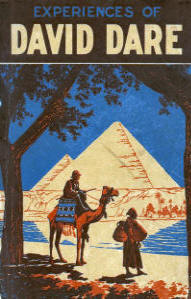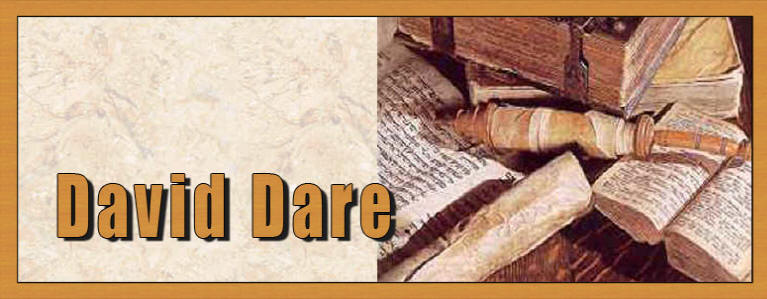CHAPTER 3THE TEST BEGINSTHE APPLAUSE THAT greeted Mr. Emerson’s demand indicated the anxiety of the audience to hear the evidence. David Dare, Bible in hand, stepped to the edge of the platform and proceeded with his talk: “For two thousand years Tyre grew in importance until she was mistress of the sea as was Babylon of the land. She was the commercial centre of the world. Carthage, the rival of Rome, was only a colony of Tyre — Tyre, the beautiful, the rich, the learned, into which flowed the fine gold of Tarshish, the precious stones of Aram, the spirited horses of Armenia, the beautiful ivories of Damascus, the fine linen of Egypt, the flocks of Arabia, the perfumes of Sheba, the slaves of Javan. “In short, Tyre was the New York of Asia. Ships from all nations anchored in her harbour and their passengers bartered in her streets. “While Tyre was at the height of her glory and power, while it would seem she must stand for ever, along came Ezekiel, who prophesied about 590 B. C., and said: ‘They shall destroy the walls of Tyrus, and break down her towers: I will also scrape her dust from her, and make her like the top of a rock. It shall be a place for the spreading of nets in the midst of the sea: for I have spoken it, saith the Lord God: . . . and they shall lay stones and thy timber and thy dust in the midst of the water. . . . and I will make thee like the top of a rock: thou shalt be a place to spread nets upon; thou shalt be built no more: for I the Lord have spoken it, saith the Lord God.’ Ezekiel 26:4-14. “Immediately after the giving of that prophecy, Nebuchadnezzar besieged Tyre, and after thirteen years of effort took the city and destroyed it, wreaking fearful vengeance on buildings and people.” Here one of the audience jumped to his feet. “You cannot prove the prophecy was written before Nebuchadnezzar’s time. According to your own statement, Ezekiel was contemporary with the king.” “True,” agreed David Dare, “While personally I believe the prediction was made before Nebuchadnezzar besieged Tyre, I shall not refer merely to that siege. Though the prophecy began with the king of Babylon’s siege, its predictions looked more than two thousand years into the future, as we shall see. “Observe that while the ruins of the old city remained after Nebuchadnezzar’s time, the prophecy declared that the timbers and rocks and even the very dust should be cast into the sea, leaving a bare rock to be used for spreading nets. “This prediction was not fulfilled by this king of Babylon, and it seemed improbable it ever would be fulfilled; for if Nebuchadnezzar, in his anger, had taken full vengeance, and had not thought of this, who was likely to care enough about the ruins of a deserted city to be so violently destructive? It would be the very frenzy of madness. But meanwhile there stood the prophetic words, awaiting fulfillment. “Two and a half centuries passed, and still the ruins stood, a challenge to the accuracy of prophecy. Then through the East the fame of Alexander the Great sent a thrill of terror. He marched swiftly to attack new Tyre, 332 B. C. Reaching the shore, he saw the city he had come to take, with half a mile of water surging between them, for it was built on an island. Alexander’s plan of attack was speedily formed and vigorously executed. He took the walls, towers, timbers, and ruined houses and palaces of the ancient Tyre, and with them built a solid causeway to the island city. So great was the demand for material that the very dust was scraped from the site, and laid in the sea.” When the original objector made no movement, Mr. Emerson stood up to speak. “I grant the statements you have made concerning Tyre are true, but what of it? It will be impossible for you to prove that the supposed prophecy was written before the events it describes. At this great distance from the events, three or four centuries is a small matter. Your argument is far from conclusive, and I for one believe the Book of Ezekiel was written after Alexander’s time.” Lecturer Dare smiled in reply: “Perhaps the fact that the events fit the prediction has much to do with your conclusion.” “And perhaps the fact that history verifies Ezekiel’s prediction,” retorted Mr. Emerson, “has much to do with your belief that the prediction was written first. My assumption has as much foundation as yours, and is more reasonable.” “You overlook three great difficulties in your view,” replied Mr. Dare. “First, the Encyclopaedia Britannica, fourteenth edition, Volume 9, pages 13, 14, under article, “Ezekiel,’ is emphatic in stating that the Book of Ezekiel was written 586-450 B. C., and this is the extreme critical view. Thus, according to the sceptical version, the prophecy is still 118 years before the event. But we will pass to the second difficulty. “When you claim Ezekiel pretends to foretell what in reality was written after the event it professes to predict, you make a book of otherwise high moral teaching a most vicious book, dealing in deception of the basest sort. “But, Mr. Emerson, while you create these two difficulties for yourself, there is still a third inherent in your position that no sceptic can remove. “I will admit, for the sake of the argument, that the book was written whenever you desire, say 330 B. C. Even you cannot claim a later date.” Mr. Emerson nodded agreement. “Perhaps you forget there are other particulars in the prediction besides destruction. In some prophecies the cities were to be destroyed and rebuilt. Such was the fate of Jerusalem, which still exists. “The third difficulty of your view is that old Tyre was to be built no more. This divine sentence of judgment has been a challenge down the centuries to every unbeliever in earth. God has had a challenge sounding for twenty centuries, daring you and every other sceptic to rebuild this city and thus disprove His Word.” “I never heard of such a thing,” gasped Mr. Emerson in surprise. “Are you serious?” “Certainly,” replied David Dare, “never more so. I will next tell you how to disprove the Bible.” |


